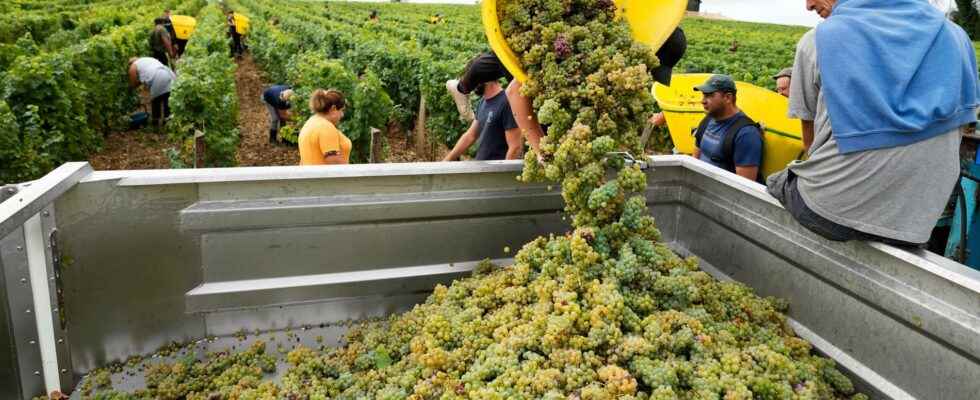Published: Less than 30 min ago
full screen
Next
The grapes are being harvested record early this year at Château Carbonnieux in southern Bordeaux, France.
1 of 2 Photo: Francois Mori/AP/TT
The drought and heat have forced French winegrowers to harvest earlier than ever. If the climate continues to get warmer, the quality may be affected, worried growers fear.
– We know that vineyards are affected worldwide, says Kimberly Nicholas at Lund University.
The grapes in the famous French wine region of Bordeaux, which were previously ripe for harvest in mid-September, have this year been ready for harvest already in mid-August. The reason is the severe drought, from the end of June to the middle of August, as well as the adaptations that the wine producers have made to an increasingly warmer climate. The situation is similar in several places in Europe, reports the news agency AP.
Harvests are estimated to be 15 to 20 percent less in the region this year, says Fabien Teitgen who is technical director at Château Smith-Haut-Lafitte in southern Bordeaux. Partly the grapes are smaller in size, partly some were burnt in the hot sun. The drought has caused the winery to change its working methods, among other things, the ban on watering established plants has been removed.
– Some crops suffered badly, with leaves falling, says Manon Lecouffe, who managed the watering, to AP.
“Freshness is lost”
So far, the quality of the grapes has not been affected, and the dry and warm weather has meant that, for example, attacks by powdery mildew have escaped. But the growers are worried about the future.
– If the temperature rises a single degree, the freshness in the balance of the wine will be lost, says Fabien Teitgen.
Experts are now considering planting entirely new varieties to adapt to the climate changes that have become commonplace for growers.
– We have to think again. There are many tools that we have not yet tried, and that are used in warmer regions, says CEO Laurent Lebrun at Château Olivier.
In regions of Italy, Spain and Portugal, harvests are estimated to be between 10 and 20 percent less than normal this year. High fuel and material costs at the same time risk increasing producers’ costs by 35 percent, warns Italy’s largest agricultural organization.
The increasingly warmer winters are also a danger, when plants that bud in early spring are at risk of being taken by the frost. The industry fears that mainly smaller growers will find it difficult to cope.
Limit of adaptation
For Kimberly Nicholas, climate researcher and university lecturer at Lund University’s center for studies of sustainable social development, the alarm from the French winegrowers does not come as a surprise. Nicholas, who was born in California, has since 2003 studied precisely the impact of climate change on viticulture, and how the cultivation can be made more sustainable.
– It has been a trend for decades now. The harvest comes earlier, which is linked to a warmer climate. There are adaptations to some extent that growers can make, but there is also a limit. It is not possible to adapt to catastrophic climate change, she tells TT.
The wine industry is changing. It is partly about reducing one’s own emissions, and partly about adapting to the changes that are already taking place and that cannot be avoided.
– The point is to avoid what we cannot adapt to, and adapt to what we cannot avoid.
“Must change”
Wine can be considered to belong to the golden edge of existence. Even more worrying is that climate change has already reduced the harvests of what is consumed the most and on which humanity depends; wheat, soy and corn.
– Agriculture everywhere is sensitive to the climate and the human-caused climate changes. It is a very important alarm, we must change to a fossil-free society with a more sustainable agriculture if we want to continue to have a good life on earth, says Kimberly Nicholas.
Facts
Wine and the climate
Grapes are very sensitive to the climate they grow in. Based on the grape’s taste, it is possible to draw conclusions about where it was grown, how it was grown and what the climate is like. When the climate changes, so does the taste of the wine.
In a warmer climate, more sugar develops in the grape, which leads to a higher alcohol content and less acid in the wine. This makes the wine less suitable to drink with food.
The number of flavor components, which normally increase towards the end of the growing season, becomes fewer when the wine is harvested earlier.
Moving the cultivation of wine to a better suited climate is not easy, as it often involves an entire culture and generations of knowledge.
Source: Lund University, Kimberly Nicholas
Read more
